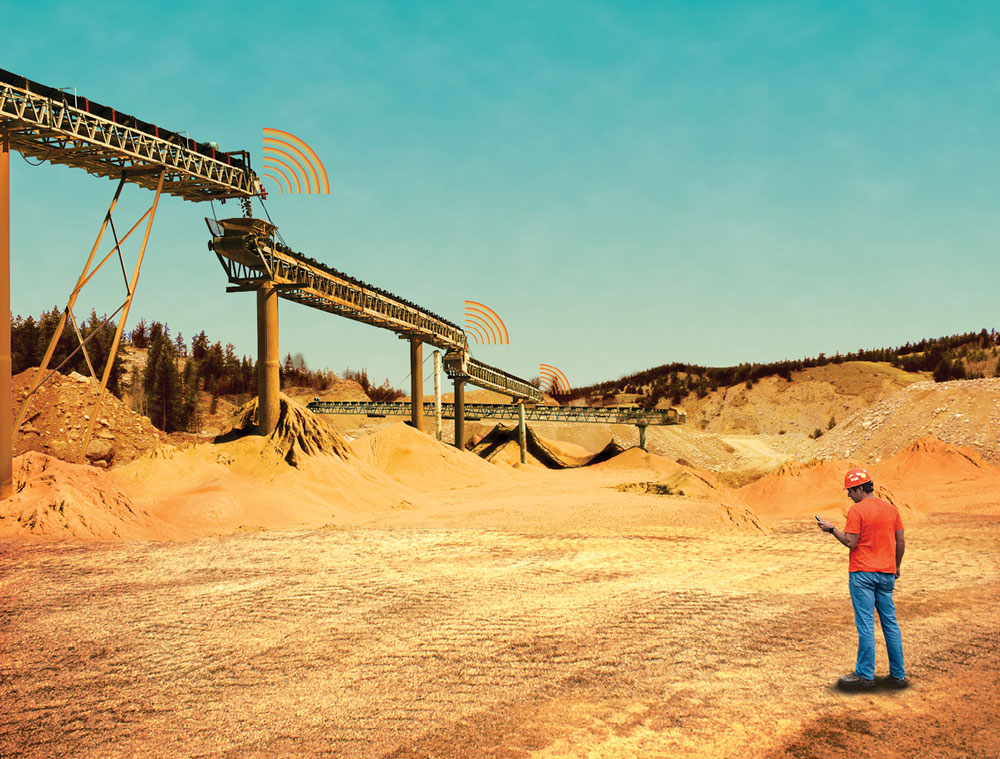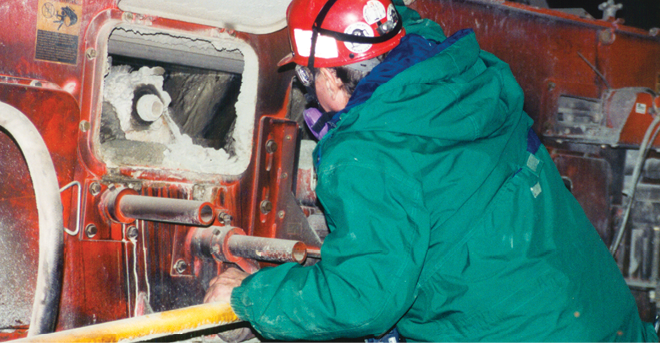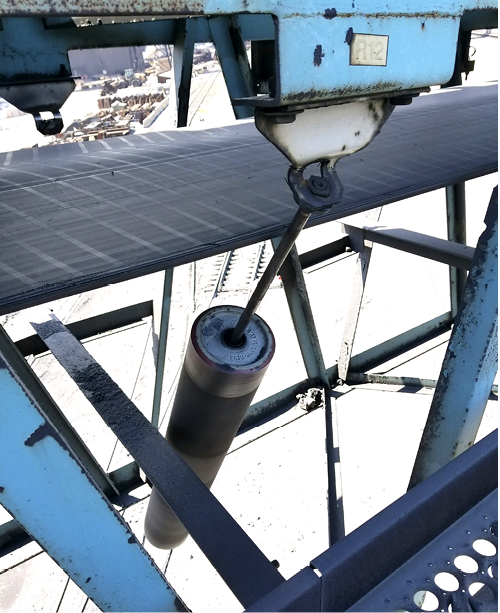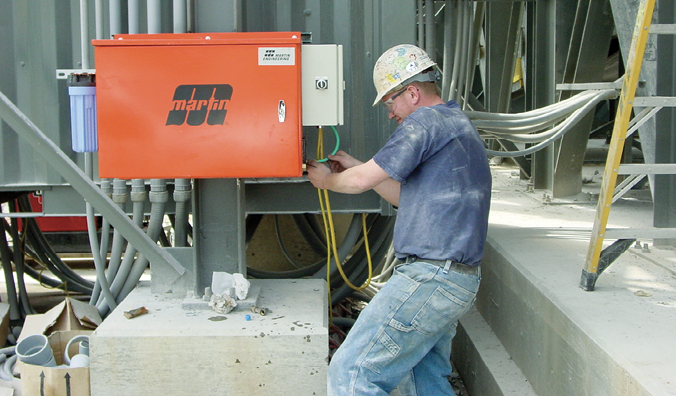Remote monitoring is not new, but it is constantly changing. How is it changing safety and efficiency for mines?
By Andrew Timmerman, P.E.

From their conception, conveyors were designed to automate bulk handling and make production faster, less labor intensive and safer. The scale of modern operations can involve dozens of conveyors transporting millions of tons of cargo through a labyrinth totaling miles of belting.
Physically inspecting a system is important but can be time-consuming, and access to a running conveyor is (and should be) limited by design for safety. In the face of this reality, it’s a natural progression to further automate.
Over the last century, automated monitoring systems have been introduced such as load sensors, automatic shutoff switches and fire detection systems. Still in use today, these are reactionary systems that are triggered by indicators once a problem has potentially reached a critical stage, such as a drifting belt or a fire.
Although these improve workplace safety and prevent larger catastrophes, they do not prevent downtime or detect causes of problems.

Maintenance: reactive, preventive or predictive
Effective upkeep of high-tonnage conveyor systems is critical to maintaining production and profitability, and conveyor operators need a comprehensive plan with a foundation built on workplace safety. Formulating such a strategy requires an understanding of the advantages and limitations of reactive maintenance (RM), preventive maintenance (PM) and predictive maintenance (PdM), with goals that include minimizing unscheduled downtime, improving safety, raising efficiency and reducing the overall cost of operation to achieve a better return on investment (ROI).
Even today, many companies practice what can be called reactive maintenance on their conveyors, meaning they simply fix whatever breaks. Components are left to run until they fail, and the resulting system downtime is unscheduled, disruptive and expensive.
Among the contributors to the costs of this approach are unplanned production stoppages, ancillary equipment damage (when a broken component damages something else), overtime and emergency service fees.
Despite the clear downside of a predominantly reactive strategy, it’s been estimated that half of all conveyor maintenance activities follow this approach. The obvious reason is budget: reactive maintenance requires fewer workers, less planning and a lower initial investment.
But such a strategy leads to ineffective planning, insufficient oversight and far less system control. It also leads to significantly higher costs over the life of a system.
The deficiencies of reactive maintenance have driven an evolution to a more preventive approach to minimize failures that force unplanned shutdowns for repairs. Guidelines are typically based on time in service or operating hours.
The idea of PM has been around almost since the invention of the wheel: performing regular maintenance on equipment to reduce the chances of failure. It’s the same approach that consumers use when they take their car in for scheduled oil changes to extend engine life. PM prolongs component life, increases productivity, improves overall efficiency and reduces maintenance costs.
Some firms take this responsibility in-house, but others find that specialist service providers deliver a better return on their maintenance investment, relying on the expertise and scheduled maintenance from industry experts so their employees can focus on core activities. Generally triggered by time, metered inspection or common indicators (mistracking, spillage, etc.), the PM approach to conveyor maintenance assumes that each component has a typical equipment life based upon previous similar applications and environments.
Using observation and experience, PM determines when relevant parts should be retired, replaced or refurbished before the expected failure point. The result is generally greater safety, higher system efficiency, reduced spillage and better overall system control than using a reactive approach.
Predictive Maintenance (PdM) directly monitors equipment performance during normal operation to more accurately anticipate failure. Relying on sensors and supported by software, it collects information over time, aggregates the facts and uses an algorithm to deliver a practical result that is made available to stakeholders.
When combined with regular physical inspections, this type of data-driven system provides far more complete, accurate and actionable information for service technicians and operations personnel.
Some component manufacturers offer structured conveyor inspections and belt cleaner maintenance as part of a managed service relationship. Their monitoring systems can track component wear and update the service technician and/or operations team via wi-fi or cell phone on upcoming service needs. The technology will also send an alert through a mobile app in the event of upset conditions, allowing service technicians and plant operators to access real-time data. There are some new systems that can even adjust belt cleaner tension automatically.
Unlike PM that is determined by an average or expected life statistic, PdM is based on the actual condition of the equipment. Sometimes called “condition-based maintenance,” when predictive analysis identifies a potential issue, the repair can be scheduled at a time that minimizes the impact on production. The benefits include further optimized system performance and component life, reducing the need for visual inspection and minimizing guesswork through a more automated, analytics-based system. Although it doesn’t fully eliminate the need for personal inspections and maintenance, for conveyor systems that can be miles long and, in some cases, cover difficult terrain, the approach saves time and reduces potential hazards.

Remote monitoring
Modern remote monitoring systems collect data and provide real-time status needed for PM and PdM. This data helps inform system efficiency improvements and avoid unscheduled downtime to reduce manual labor and ensure maximum performance. Monitoring systems are an essential component of making PM and PdM more effective.
A PdM program starts with data collection and storage, and then proceeds to analysis. In the past, adding new points of measurement was a time-consuming and expensive undertaking, but wireless instruments have greatly reduced these costs. With more readily available data collection, storage and analytics options, some bulk material handlers are recognizing that each critical component can and should be monitored and analyzed to optimize performance.
Sensors can also feed data to cloud-based software which then broadcasts it to mobile apps in the field. The benefits of extended equipment life, tighter budget forecasting, more reliable maintenance scheduling, increased worker efficiency, decreased downtime and better productivity all add to a swift return on investment (ROI).
Safer monitoring
There is rarely a time when personal inspection of any system component is not needed at some point. Walking along a conveyor system and around a transfer point allows for all senses – looking, listening, smelling and feeling (vibration, shaking, etc.) – to help experienced operators diagnose issues. However, the process is labor-intensive, and there is always the chance that exposure to a moving system can lead to workplace safety issues.
The smell of rubber, the presence of smoke, odd clanking, etc. makes any operator curious and want to inspect further. The simple act of bracing against the stringer to peer under the conveyor, though, can cause incidental contact with the belt, and opening an inspection door can leave the viewer vulnerable to flying debris. The list of possible hazards is long.
Remote monitoring supports keeping schedules on track by offering data through either logistical software or an online app that tells supervisors and managers when potential issues might arise. By inserting preventive maintenance tasks into a schedule, with the help of remote monitoring predictive maintenance will eventually become the standard approach.
Heat sensors, dust sensors and load sensors can detect the indicators of problems immediately from within the system even before sensory-based cues. Automated monitoring is much more sensitive and reliable than human inspection, allowing detection of these potential trouble indicators before humans can.
Unlike PM, which relies on wear life determined by manufacturer and/or operator observations, machine learning adapts maintenance needs to the operation and service environment, fueled by all previous input. The benefit is a tailored experience that has the effect of equipment seeming to communicate its needs directly to decisionmakers.
Of course, there is also the preventive factor. Sensors digest vast amounts of data and provide information to operators, allowing them to prevent major issues, rather than reacting to them. Wear parts like belt cleaners and aging idlers can be swapped out before problems related to idler seizure or cleaner pull-throughs can cause belt damage, mistracking or fires.

Improved efficiency
Safety should be top-of-mind for any operator, but a capital investment in monitoring technology will also positively impact production and efficiency. The most common conveyor-specific monitoring devices include cameras which provide an overall view of conditions. Operational sensors can also monitor equipment conditions, and flow sensors provide important data regarding volume and efficiency.
Position indicators are intuitive sensors that remotely monitor the belt cleaner position and remaining blade life to improve cleaning efficiency and reduce labor. Estimating when blades need changing is often a guessing game that, if left too long, could lead to expensive belt damage. These systems also warn when the blade is no longer in contact with the belt due to wear, high temperatures, detachment or a pull-through condition, helping to prevent a catastrophic failure.
Position Indicator alerts are also provided automatically when:
- A blade change is required
- Re-tensioning is needed
- A cleaner has been backed off the belt
- An abnormal condition occurs
- A high-temperature condition is detected
The devices deliver critical real-time intelligence and reduce worker exposure to moving conveyors, improving both efficiency and safety. Maintenance planning is simplified by having detailed information available on demand, allowing service personnel to deliver and install replacement wear parts during scheduled outages. Relying on actual operating conditions instead of human judgement to monitor blade wear and tension for optimal cleaning performance, the indicator maximizes the blade’s usable surface area and reports with certainty when a blade is nearing the end of its useful life.
Load sensors monitor whether there is a load on the belt and approximately how much. An empty belt is an indicator of ongoing maintenance, unintended production disruptions or flow issues. They also communicate with automated tensioning systems so the unit can pull the blade away from the belt when there is no cargo. Running a blade on an empty belt can reduce blade life, degrade the belt face and create potentially dangerous friction heat and static.
Flow indicators, or plugged chute detectors, can alert operators to the need for maintenance. With machine learning and logistics software, they can automatically activate flow devices like vibrators or air cannons to disrupt stuck material and resume normal flow. This prevents common unsafe work practices to clear clogs like banging on the side of chutes, poking the clog from below with a tool or entering the vessel to dislodge accumulated material.
Moving beyond remote monitoring
New technologies are now evolving beyond monitoring to actually making system changes without human intervention, such as an autonomous belt cleaner tensioning system that continuously monitors and adjusts proper cleaner tension. The device ensures proper tension to optimize cleaning performance and reduce labor while improving safety and reducing the cost of operation.
Prior to the new design, belt cleaner tensioners had to be monitored and adjusted manually, in some applications on a daily basis, so they would maintain optimum pressure and carryback removal.
Aside from just providing performance data, custom-developed apps deliver status updates and alerts of equipment, sent to operators based on specific data-driven criteria. Also, reviewing the capability of the sensors with remote monitoring equipment helps determine other options that may be needed to better prevent problems.
Remote monitoring is not new, but it is constantly changing and innovating with the goal of improving efficiency and workplace safety. Although humans will always be needed in some capacity, interaction with the system should be limited to an as-needed basis, and remote monitoring is the best solution to achieve that goal.
Andrew Timmerman is a professional engineer (PE) and the product development engineer for Martin Engineering.
